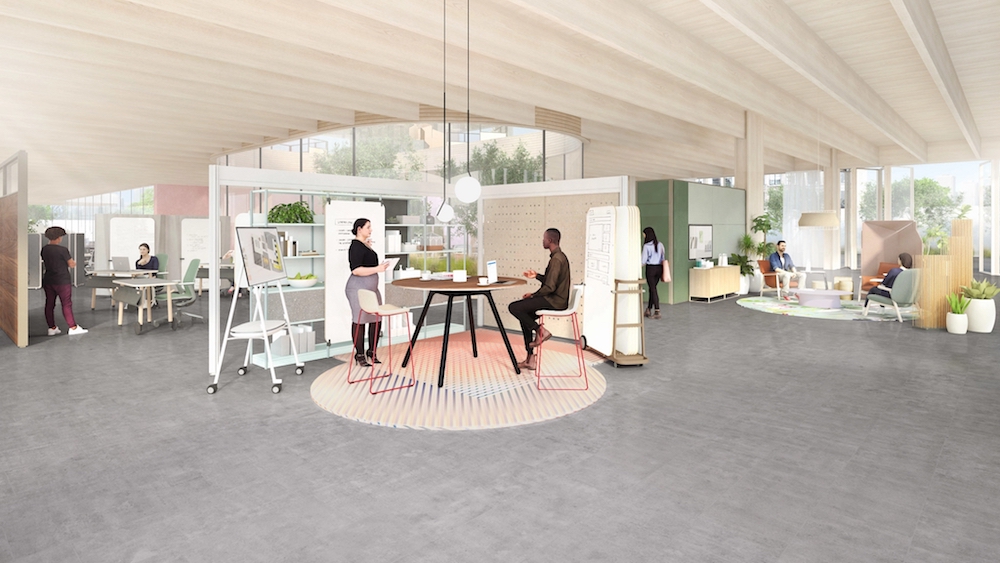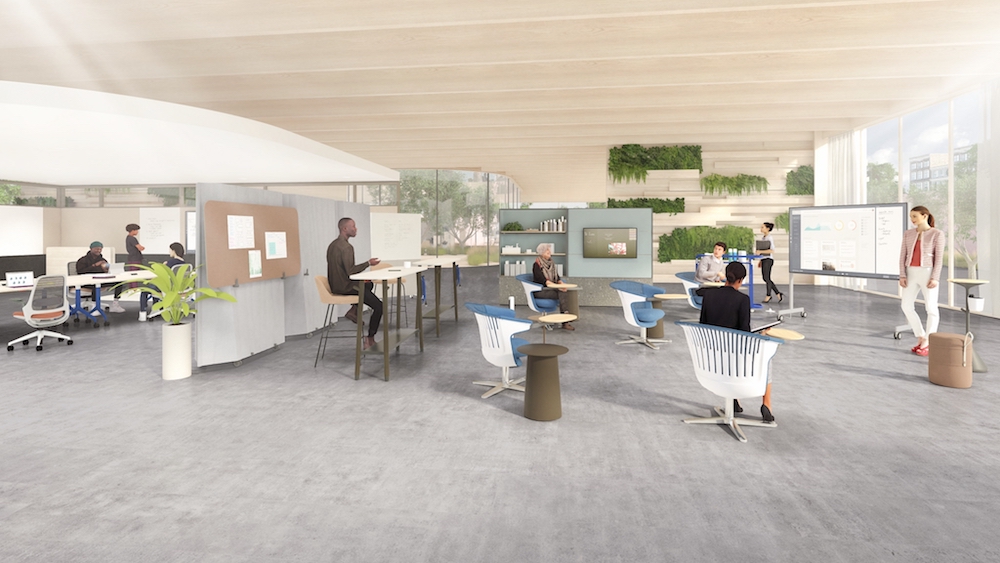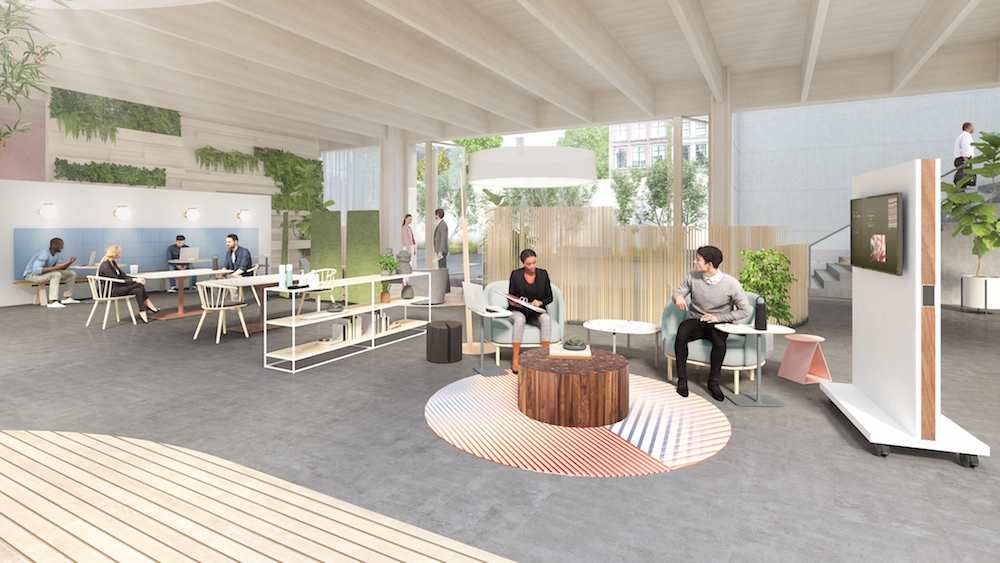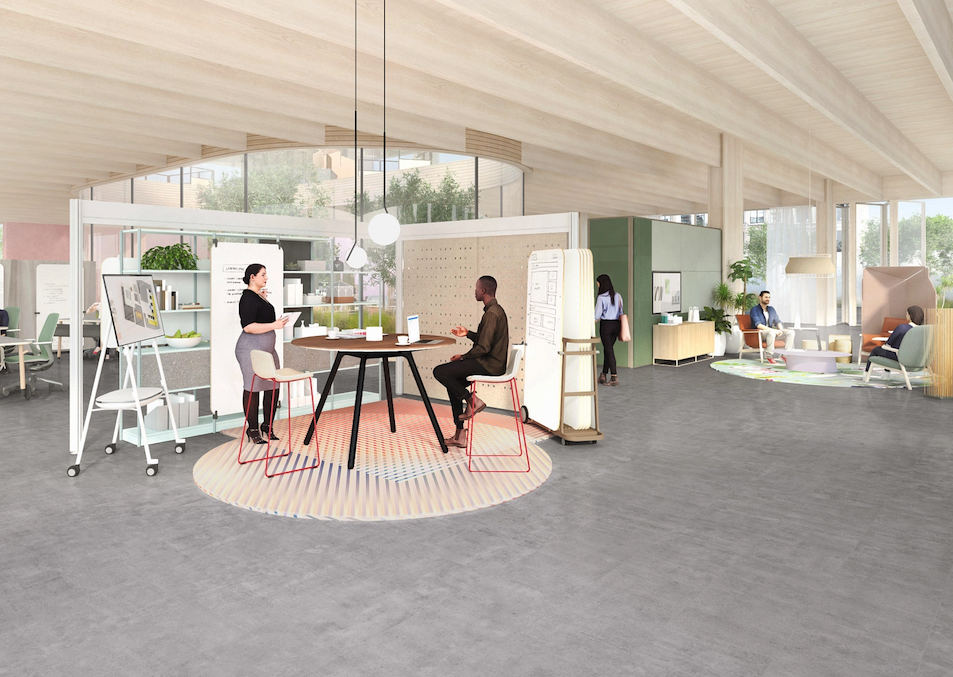Great workplaces can support wellbeing in many ways. Steelcase’s Tracy Brower shares a few options to consider as we return to work.

As we turn the page on 2020 and herald hope and anticipation for 2021, we have a great opportunity to apply all we’ve learned. We can facilitate people’s successful return to the office, but we have the chance to do more—to get back to something better—and to create the conditions for holistic wellbeing.
One of the unanticipated benefits of working from home has been an increased appreciation for the office. Through its absence, people are reminded of how much they value working face-to-face with colleagues and feeling the motivation that comes from gathering for a shared purpose. Even the variety and stimulation that come from a change of venue are things people crave.
While working from home has had its advantages, it has also introduced challenges in terms of comfort and wellbeing—physical, cognitive and emotional.
- In recent Steelcase research across 10 countries during September 2020, people reported their most significant struggles in working from home included a sense of isolation, reduced productivity, speed of decision making and reduced engagement. In addition, the study found when people were unhappy and also worked from home frequently, their engagement dropped 14 percent and their productivity dropped 12 percent.
- In another study, 75 percent of people felt socially isolated. This was correlated with working from home: the more they worked from home, the more socially isolated they felt.
- In additional research, 78 percent of people reported negative impacts to their mental health since working from home. In addition, 42 percent reported reduced productivity and 40 percent said the quality of their decision making had deteriorated. Twenty-five percent reported burnout.
- Yet another research effort found 64 percent of people were suffering from one or more new physical health issues since working from home.
With the negative effects of working from home, the office has an opportunity to really shine in terms of all it can do for comfort and wellbeing. Employee expectations are expanding—and they will increasingly demand both safe and compelling workplaces when they return. A healthy workplace—one that fosters physical, mental and emotional wellbeing—will be critical not only to attraction and retention, but also to engagement and development. Individuals, teams and organizations are more likely to be at their best when comfort and wellbeing are in the offing. Great workplaces can support wellbeing in many ways. Here are a handful of options to consider:
Choice, Control and Support for Multiple Ways of Working
Our recent research found that people will expect expanded control over where and how they work. While most people still want to work in the office, they also expect to continue to have the option to work from home or a third place. And when they are in the office, they expect more options including a range of spaces and ways to control their privacy. From a wellbeing standpoint, people need adequate autonomy and independence in order to avoid learned helplessness or reductions in motivation.
Choice and control are also linked with engagement. A study of almost 13,000 people, found when people had a choice of where to work, they were more likely to be engaged and satisfied at work. Engagement is good for people and for companies—coveted by business leaders for good reason. When people are engaged, they are energetic, enthusiastic and immersed in their work—all feel-good experiences. In addition, a study on engagement found when employees were more engaged, they tend to be more productive, more willing to contribute discretionary effort and more open to new information. They also take action to adapt their work environments in order to maintain the conditions needed for engagement. Providing more choice and control in the environment is predictive of engagement which is, in turn, predictive of all kinds of better performance.
An effective pathway toward choice is a workplace that includes plenty of variety—and an ecosystem of spaces. The best environments provide for all kinds of work including focus, collaboration, learning and socializing. In addition, the most effective work experiences support time alone and together as well as space that is both dedicated and non-dedicated. The pandemic has also reinforced the need for workplaces which are more flexible and fluid, and less fixed—so they can respond to business conditions and employee needs on demand and over time. Ultimately, success is found in a wealth of options, variety and flexibility—from work cafes and enclaves to phone booths and garden areas.

Performance
Wellbeing is also related to people feeling they can perform at their best. In change management efforts, one of the primary concerns employees have is whether their performance will be compromised by workplace changes. People want to make a contribution and excel at their work, and the office is an important part of this productivity. Research found two of the primary reasons people want to return to the office are to focus and collaborate—both of which are critical to productivity. A full palette of place allows for people to choose the work area which is the best match to the tasks they’re doing, and companies can contribute to this empowerment through a variety of spaces, and through leadership and cultures which allow people to feel like they can work anywhere without stigma (it really is okay to sit in the work café for a meeting or the atrium for a bit of heads-down work). Creativity and innovation result from an ebb and flow between different types of work throughout the day—the braiding of work which occurs between collaborating and focusing as well as learning and socializing.
Additionally, employees’ wellbeing and performance are best supported with an experience that brings together both the digital and physical. Technology must be accessible, responsive and integrated for all kinds of work processes. Respondents of the study reported one of their primary reasons for wanting to return to the office was because they wanted greater access to tools and technology.
Another key reason technology will be critical is that remote work is likely to here to stay. In fact, research suggests 77 percent of companies expect some amount of work from home to continue. This mixed presence—people working from multiple locations and participating in the same meetings—will necessitate conscious attention to the experience of collaboration. Companies will seek to avoid presence disparity—the unequal experiences which can result when some people are in the room together and others are remote. An interesting study found when people experienced significant social rejection—the feeling that can occur when remote participants aren’t able to participate fully—they tended to disengage and this had negative implications for them as well as the community as a whole. The use of technology to ensure greater presence equity has positive effects on performance and cognitive wellbeing—everyone can bring their best to the meeting, and it also has desirable outcomes for emotional wellbeing.
Rejuvenation
For many, the pandemic has caused work to slow down, and people have stepped off the proverbial hamster wheel of commuting, conferencing and constant contribution. Eating lunch with a child who is learning from home or taking a walk over the lunch hour have become more the norm than they were before—and these habits are very good for wellbeing. This shift in behavior will also influence employees’ expectations for the office.
One study showed breaks make people more effective because they help the brain recharge and ready itself for the next challenge. In addition, the more intense the work, the greater the need for people to take a few moments away. Productivity isn’t enhanced by constant hustle, rather it benefits from opportunities to refresh, renew and reflect. Spaces which provide for getting away and policies which allow for breaks during the day make significant contributions to wellbeing.
Stimulation
To function at our best, we need stimulation. In fact, Ingrid Fetell Lee shows, in her book Joyful, people derive more joy from environments which have plenty of color, texture and interest. On a related note, one study showed when people had more biodiversity in their environments, they were happier. Another study demonstrated when people had access to nature—even via views to the outdoors—they reported reductions in depression and increases in satisfaction. Biophilic elements have always been inherent in great design, creating interest and variety, but they may be even more important as we return from our isolation and as employee expectations expand. From daylight and views to reflective surfaces, fractals or water features, features which remind people of nature contribute to wellbeing.

Community and Belonging
Working from home has caused people to miss their colleagues and coworkers. We know from research in social psychology, when people aren’t able to connect face-to-face, incidences of morbidity and mortality increase. Community is important to individuals and also to organizations. Research found when people report a strong sense of community, there is a correlation with productivity, engagement, innovation and retention. The research also found correlations between attributes of the workplace and a strong sense of community. What mattered most were places where leaders were present and accessible. Also primary, were places which supported socialization and places that were stimulating and inspiring. The research also found one of the primary reasons people want to return to the office is for an increased sense of belonging.
A workplace designed for comfort and wellbeing helps to connect people both formally and informally. At destinations like work cafes or coffee bars, people come together. Through pathways and landmarks, people can connect. And within conference rooms and project spaces, people can confide in each other, create new solutions and cooperate toward shared goals. Wellbeing is enhanced when the place helps build social infrastructure—creating meaningful interactions that contribute to social capital and a sense of belonging and inclusion.
Privacy
While work is fundamentally social, everyone—no matter what their style—still needs adequate privacy. Humans value territory and having a space of their own. It’s important to their wellbeing to feel both physically safe and psychologically safe. Privacy contributes to these. In an 1890 issue of the Harvard Business Review, experts Warren and Brandeis advocated for the right to privacy—fundamentally, the right to be left alone. The concept speaks to social boundaries and the freedoms to choose what we do, what we share and who has access to our information.
Like so many aspects of wellbeing, this too has been affected by the work-from-home pandemic experience. People’s homes are their cocoons, and apart from close family in the household, it has been possible for many employees to have private conversations or do private work without much friction. This has caused expectations for privacy to rise—all kinds of privacy: acoustical privacy (I can’t hear others and they can’t hear me), informational privacy (people can’t see what I’m working on), visual privacy (I can’t see others, or be seen by them), and territorial privacy (I have space that belongs to me [for now]). All of these contribute to comfort and wellbeing.
Putting it All Together
Wellbeing and comfort have always been important, but with the physical, cognitive and emotional issues wrought by the pandemic, it has become crucial for offices to deliver a high level of wellbeing. Creating places that foster wellbeing will require both expertise and empathy. I worked with a brilliant designer who used to talk about offices which were clearly conceived by “smart people who care.” He imagined a 2×2 model with expertise (smarts) on the vertical axis and empathy (caring) on the horizontal axis. The best designs demonstrated compassion and focus on the experiences necessary for people to thrive. They also demonstrated terrific capability and creativity in terms of the design that worked best to create the conditions for wellbeing. This is what we’ll need to be going forward—smart people who care and who contribute to comfort and wellbeing—and to working better.


